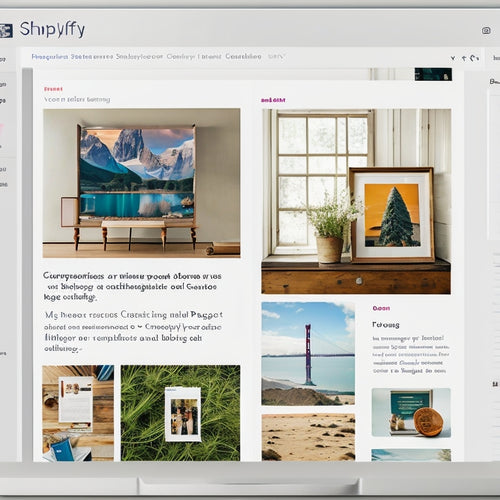
Bundling Strategies: Enhancing Supply Chain Efficiency
Share
Bundling strategies have emerged as a powerful tool for enhancing supply chain efficiency by optimizing inventory levels, streamlining logistics, and reducing costs through innovative product offerings and pricing dynamics. By mitigating risks in inventory management and improving demand forecasting, bundling enables businesses to employ dynamic pricing strategies, leading to increased revenue and reduced waste. Market segmentation and coopetition strategies can be employed to create targeted bundles, capturing a larger share of consumer surplus and enhancing supply chain efficiency. As businesses explore bundling opportunities, they can uncover new avenues for improving supply chain operations and increasing customer value.
Key Takeaways
• Bundling strategies improve supply chain efficiency by streamlining logistics, reducing costs, and enhancing delivery times.
• By offering multiple products together, bundling enables dynamic pricing strategies, improving demand forecasting and inventory management.
• Coopetition in supply chains fosters collaboration and competition, resulting in more inclusive and appealing bundles that capture a larger share of consumer surplus.
• Optimizing inventory levels and consolidating shipments reduce costs, while enhancing supply chain visibility and transparency enable data-driven decision-making.
• Effective bundling strategies lead to increased revenue through optimized pricing, improved customer value, and enhanced supply chain efficiency.
Bundling for Uncertain Demand
When faced with uncertain demand, firms often employ bundling strategies to mitigate the risks associated with inventory management, by offering multiple products together at a discounted price. This approach enables firms to optimize inventory levels and reduce the likelihood of stockouts or overstocking.
By bundling products, firms can also improve demand forecasting, as the aggregated demand for multiple products is often more stable than individual product demand. Additionally, bundling allows firms to implement dynamic pricing strategies, where the bundle price is adjusted based on demand fluctuations.
Effective bundling strategies can lead to improved inventory management, reduced waste, and increased revenue through optimized pricing.
Market Segmentation Strategies
Market segmentation strategies, an important aspect of bundling, involve dividing the market into distinct groups based on consumer preferences and willingness to pay, allowing firms to tailor their bundles to specific customer needs and maximize revenue.
By segmenting the market, firms can identify high-value customers and offer them premium bundles, while also catering to price-sensitive consumers with more affordable options.
-
Segmentation benefits include increased customer satisfaction and loyalty
-
Targeted pricing enables firms to capture a larger share of consumer surplus
-
Firms can create bundles that appeal to specific demographics or psychographics
-
Market segmentation helps firms to identify and respond to changing consumer preferences
-
Segmentation strategies can be used in conjunction with other bundling approaches to enhance supply chain efficiency
Coopetition in Supply Chains
Coopetition in supply chains, where firms collaborate and compete simultaneously, offers a promising approach to bundling strategies, enabling companies to leverage each other's strengths and expertise to create more attractive and competitive bundles. This coopetition dynamics allows firms to pool their resources, share risks, and jointly innovate, resulting in more inclusive and appealing offerings.
Enhancing Supply Chain Efficiency
A well-designed bundling strategy can greatly enhance supply chain efficiency by streamlining logistics, reducing inventory costs, and improving delivery times, ultimately leading to increased customer satisfaction and loyalty.
To achieve this, bundling strategies can:
-
Optimize inventory levels through inventory optimization, reducing waste and excess stock
-
Reduce costs through cost reduction initiatives, such as consolidating shipments and minimizing transportation expenses
-
Improve delivery times by streamlining logistics and reducing lead times
-
Increase flexibility and responsiveness to changing market demands
-
Enhance supply chain visibility and transparency, enabling data-driven decision-making
Industry Applications and Considerations
In various industries, bundling strategies have been successfully employed to capitalize on synergies between products and services, offering valuable insights into their application and implementation considerations.
The telecommunications sector, for instance, has utilized bundling to enhance pricing dynamics, where service providers offer discounted rates for bundled services, such as internet, TV, and phone. Strategic partnerships have also been formed to offer joint bundles, increasing the appeal to customers.
In the fiber-to-the-premises (FTTP) industry, bundling has been used to facilitate wholesale-retail splits, enabling service level competition and structural separation for price discrimination. These industry applications demonstrate the effectiveness of bundling strategies in improving supply chain efficiency and enhancing customer value.
Frequently Asked Questions
How Do Consumers Perceive the Value of Bundled Products?
As consumers weigh their purchasing decisions, they meticulously assess the perceived value of bundled products, influenced by their individual preferences and pricing strategies that align with market demand, ultimately driving their willingness to pay.
Can Bundling Strategies Be Applied to Perishable Goods?
When considering bundling perishable goods, temperature control and shelf life become essential factors, as improper storage can lead to spoilage, compromising product safety and quality, thereby requiring tailored logistical strategies to guarantee ideal handling and preservation.
What Role Does Product Complementarity Play in Bundling?
Just as a conductor harmonizes discordant notes, product complementarity orchestrates bundling success, creating cross-selling opportunities that resonate with customers, and informing pricing strategies that strike a balance between profitability and consumer appeal.
Are There Any Limitations to Bundling in E-Commerce Platforms?
In e-commerce platforms, limitations to bundling arise from complex pricing strategies, diverse customer preferences, and intense market competition, which can hinder effective bundle customization, ultimately compromising the benefits of bundling.
Can Bundling Be Used to Reduce Inventory Holding Costs?
According to a study, 43% of businesses report inventory holding costs as a significant challenge. Bundling can be an effective strategy to reduce inventory holding costs by promoting inventory optimization, as it enables cost reduction through decreased storage needs and lower inventory levels.
Related Posts
-
Enhance Your Visual Branding With Customizable Templates
In today's competitive marketplace, visual branding plays a crucial role in attracting and retaining customers. One ...
-

How Do I Optimize My Website for SEO Shopify
This article examines strategies for optimizing websites on the Shopify platform for search engine optimization (SEO...
-

What Is the Difference Between a Blog Post and A Page on Shopify
This article aims to provide a comprehensive understanding of the distinction between blog posts and pages on the Sh...

